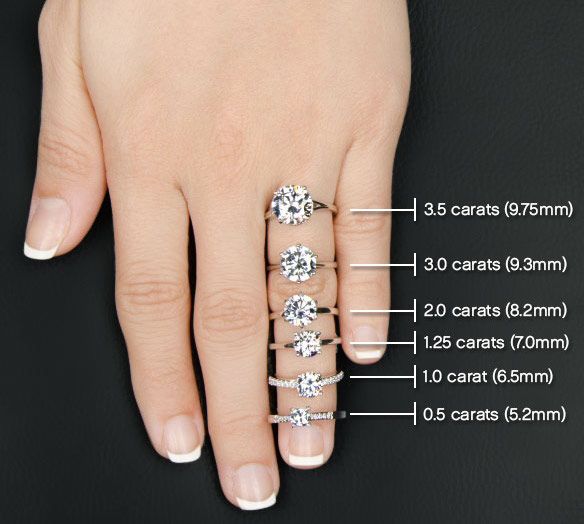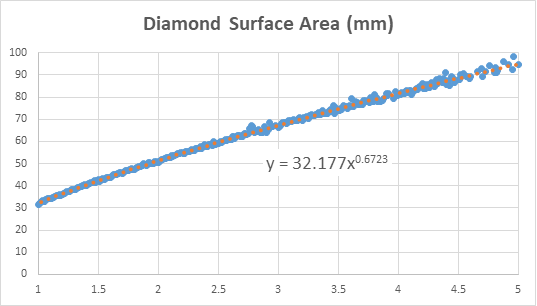January 27th 2022
What To Know About Diamond Carat Size
By Devin Jones
Carat is probably the most easily discernible and defining aspect of a diamond. Here we explore and advise you on exactly what to consider when choosing the carat size that's right for you.
🛡️ Check your diamond 💎 Search 2M+ diamonds
What To Know About Diamond Carat Size
Diamond size is measured in terms of “carat size”, which is actually a measure of the diamonds weight, not how large the diamond appears to the naked eye. One carat is equivalent to 0.2 grams, which is about the same weight as a paperclip. Let’s get a feel for how diamonds of different carat weights appear visually. The image below depicts a hand displaying 6 different round diamonds weighing between 0.5 and 3.5 carats. You can see more more shapes in similar comparisons here on Pinterest.

First, the obvious points. Look at the 1.0 carat diamond (second from the bottom) in comparison to the 3.5 carat diamond at the top. Huge difference right? Now look at the 2.0 carat versus the 3.0 carat, not as noticeable. In fact, StoneAlgo has researched the visual surface area of diamonds extensively and there are some findings that are worth sharing. Here’s a chart of the average surface area for round diamonds with carat on the x-axis (bottom labels) and surface area in millimeters on the y-axis.

While it makes sense to measure the weight of diamonds to figure out how large they are, as consumers we only end up enjoying the part of the stone that is visible from the top of the setting when a diamond is used in an engagement ring. This means if we have two diamonds of the same weight and brilliance, the one with the larger visible surface should be the more attractive stone since it appears larger to the naked eye.
The chart above displays the average surface area for round diamonds of various carat sizes. What we learned from this study is that a diamond’s surface area increases by 60% when you step up from a 1 carat stone to a 2 carat stone, but by only 31% when you step up from a 2 carat stone to a 3 carat stone. The difference between a 3 carat and a 3.5 carat stone? Only 10%. So as the carat size increases, the surface area increases by a smaller and smaller percentage – meaning the human eye is less likely to pick up on the change (think about the 2.0 vs 3.0 carat images in the first picture you saw). For this reason, we don’t advise you to purchase stones outside of your budget – you can save money while hardly decreasing the visual appearance of your stone.
The decreasing change in surface area is even more meaningful when you take into account the change in the prices of these stones. Let’s start with a 1.5 carat I VS1 diamond – according to our diamond price calculator this triple excellent, GIA certified stone at around $9,665. Now, our surface area study indicated that moving up from a 1.5 to a 2 carat diamond was an increase in surface area of 21% (see the table below) – so we’d expected the price to increase to a little less than $12,000 right? Way off – the cost of a 2 carat I VS1 is $16,586 or a 72% increase in price! This ratio of visual surface area percent change (21% here) to price percent change (72%) is just as dramatic in the larger stones as well. It’s expensive to go big with diamonds.
🛡️ Check your diamond 💎 Search 2M+ diamonds
StoneAlgo's Recommendation For Carat Size
What carat size is right for you? It comes down to answering a few questions: what is your budget for the diamond, which factors do you care about most (color, carat, or clarity) and what is the minimum carat size you are willing to consider? If you want a large carat size you’ll need to compensate somewhere else, either by raising your budget or by moving down in color and/or clarity to make it work. The StoneAlgo algorithm does this automatically for every search to show you alternative options that might be attractive to you.
🛡️ Check your diamond 💎 Search 2M+ diamonds
Should I Focus on Color or Clarity?
Diamond buying is all about making small tradeoffs to maximize the criteria you care most about, whether that means getting the largest diamond or the highest quality stone (or somewhere in between) is a matter of preference that every buyer must determine. One thing you should know before you begin investigating tradeoffs is that going one grade lower in clarity will save you less than going one grade lower in color. It’s also important to consider that above a certain point, no one will be able to see the difference between a perfect diamond and a very good diamond unless they have a magnifying glass or a diamond of significantly higher quality to compare it to. We typically recommend you begin your search at I color, VS2 clarity and always see what the diamond market looks like for better or worse colors and clarities while requesting videos and images of every diamond you are interested in buying.
